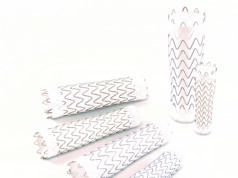
In a Gore-sponsored satellite symposium at the 2021 Charing Cross (CX) Digital Edition (19–22 April, online), Richard Neville (Falls Church, USA) and Walter Dorigo (Florence, Italy) talked through their data and experiences of below-the-knee bypass, citing the benefits of heparin-bonded polytetrafluoroethylene (ePTFE).
Dorigo took to the virtual podium first to discuss findings from a multicentre Italian registry. Recent literature confirms that open surgery still plays an important role in the treatment of critical limb ischaemia (CLI), particularly in the femoropopliteal setting, he told CX audience. The most recent European Society for Vascular Surgery (ESVS) guidelines name open surgery as a key treatment consideration in patients with long occlusion of the superficial femoral artery, both in claudicants and in CLI patients, provided good quality greater saphenous vein is available.
“However, an adequate calibre, good quality great saphenous vein may be lacking in up to 40% of patients, and in some 25% of patients with CLI,” Dorigo noted. “Moreover, the results of alternative vein sources are not so satisfactory in comparison with greater saphenous vein. For this reason, in particular conditions, the use of a prosthetic graft may be unavoidable.
When choosing which prosthetic graft to use, Dorigo advised using one which reduces the risk of thrombogenesis. He informed listeners that the most commonly used graft is the heparin-bonded polytetrafluoroethylene (ePTFE) graft, which he said provides better primary patency rates in comparison with standard ePTFE in patients with CLI undergoing femoropopliteal bypass.
Dorigo and colleagues’ institution is the coordinating centre of an Italian registry on the use of heparin-bonded ePTFE grafts. “Today, we have more than 1,300 heparin-bonded PTFE grafts, mainly in the below-the-knee setting in patients with CLI,” Dorigo noted.
Analysing the role of heparin-bonded PTFE grafts in both above- and below-the-knee settings, he shared high patency rates in this real-world population.
The next steps for the registry, Dorigo recounted, are to attain prospective validation of the risk score—this is currently in submission to ethical committees—and to collect data from other European centres “in an attempt to become an international registry on the use of heparin-bonded ePTFE”. Another idea is to make a prospective comparison with the accessory saphenous vein in the future.
“On the basis of our results, we have now changed our paradigm in the treatment of CLI in patients with femoropopliteal disease,” Dorigo commented. “In patients with poor general conditions and lesions shorter than 20cm, we perform an endovascular-first strategy, whereas in a patient with a good general condition and a longer lesion, we calculate our score. If the vein is unavailable we use the heparin-bonded graft as the first option; if the vein is available but the patient has a low score, we also prefer to use the heparin-bonded graft as the first option, reserving the use of vein for patients with a high score.”
Neville sought to answer the question “Is heparin-bonded ePTFE as good as autologous vein for tibial bypass?”
He concluded: “I think bypass is the first method of revascularisation, and still plays a prominent role in our practice, with 25% of patients being offered bypass. These are patients with significant tissue loss in whom we want robust flow, or they have had prior and failed endovascular therapy. If there is a single segment great saphenous vein, we will utilise that graft. Otherwise, we will certainly not hesitate to use a heparin-bonded ePTFE with our distal vein patch technique—we believe it is the best alternative conduit. [Its use in] arteriovenous fistulae and deep venous arterialisation is under investigation, and increasingly, [in] patients with increased perioperative risk, because you can use minimal incisions and get them off the table more quickly.”













